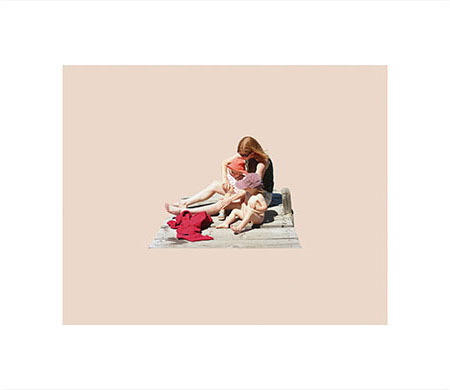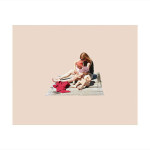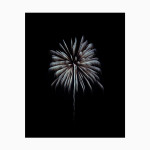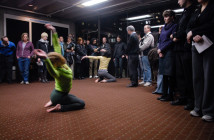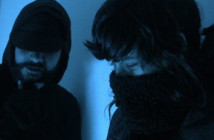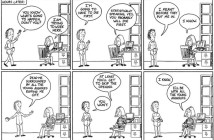Gil Blank is a photographer and writer. His photographs have been exhibited at PS1 Contemporary Art Center and White Columns, New York; The Presentation House Gallery, Vancouver; Ville d'Images, Vevey, Switzerland; Lawrimore Project, Seattle; and LaMontagne Gallery, Boston. His photographs will next be shown at Cardwell Jimmerson in Los Angeles in April 2010. His writing has been published in the monographs White Planet, Black Heart by Torbjørn Rødland and Freischwimmer by Wolfgang Tillmans, as well as in the surveys In Numbers: Serial Artist Editions, 1955 – 2008, published in 2009 by PPP Editions, and Words Without Pictures, published by the Los Angeles County Museum of Art and Aperture, the second edition of which is forthcoming in Spring 2010. He was the founding editor of Influence magazine and has served as a contributing editor to numerous independently published magazines, including Art On Paper, Issue, Tokion, and Whitewall.
Shane Lavalette: At what point did you become interested in images?
Gil Blank: Honestly, I couldn't say. There was never an epiphany moment, which I think is indicative of our age: anyone alive now was born into a culture of images. There is no contemporary existence outside of the image realm—what thirteen-year-old doesn't already know her way around Flickr or have a camera phone with her at all times?—so I don't know that anyone can speak of "coming to" or discovering images in the way that earlier photographers might have. The challenge then is to reckon as transparently as possible what meaning and value is sustainable for images within that flood.
SL: What sort of meaning and value have you found?
GB: Well, first I'd say that any meaning that the pictures might have can only be understood within the context of the pictures themselves. In fact, I think that one effective indicator of a photograph's failure is whether its meaning as such can be wholly explained away or attain an equivalency with some other means. This isn't a plea for medium-specific Formalism by any stretch, but rather an endorsement of the obdurate potential of images within the image-world, as a slippery category the potential of which we have only begun to understand.
In a larger sense though, I think that the lifelong practice of photography provides a further meaning, in that it becomes a model of lived experience, and not just its depiction. As a means of social analysis and interaction, of historical and personal questioning, of reckoning with the possibility of Realism at one's exact moment and place, and finally, as the lyrical inversion of all those things, photographic images are unique. Of this I'm convinced.
SL: My first real encounter with your work was your solo exhibition a few years ago at LaMontagne Gallery in South Boston. The show featured a number of large-scale images, ranging from firework explosions to a B2 stealth bomber to a small room dedicated to your minimalist "cities" series. How would you explain the relationship between your various works?
GB: I never make pictures with the idea of a series in mind—at least not in the classical sense. The conventional structure of the series or photo essay is linear, often didactic, and circumscribed in a way that's beautiful, but absurd. I'm sure some critics would go further and call it poisonous, but in any case I think we can settle on its uselessness to us by now. The natural proliferation of photographic images, though—their force in numbers—can't and shouldn't be simply ignored, so the question remains how we might leverage that multiplicity in a way that affords the creation of new meanings and possibilities.
I think that dovetails with the modeling I mentioned: the open-ended recombination of images that refuse the neat categorization of the series provides instead the possibility of different meanings with each arrangement, and each viewer. The photographs of fireworks and city names you saw in my exhibition are examples of such an operation, and were made with that blank ambiguity very much in mind. There are many individual variations of each (I have several hundred pictures of fireworks, for example, but it would be ridiculous to think of such a flat-footed mass as a "series"), and I often combine them with any number of other types of images. Both their content and design are highly specific and immediately identifiable, which creates a productive tension with their existence as stark, factual vacuums.
So both types of pictures adopted a very different feel and implication in the LaMontagne show than they would have on their own, because they were interspersed with images of the nuclear bomber and a memorial to FDR.
SL: I'm glad you brought this up. The notion of working with images that exist outside of the confines of a 'series' is extremely liberating, yet it seems as if relatively few contemporary photographers are working this way. Do you think it's that there is still pressure (from institutions or galleries, for example) to create 'bodies' of work?
GB: The pressure is two-fold. It stems first from the presumption that photography's inherent multiplicity somehow implies that it is also inherently didactic. This is a quintessentially Modernist conceit, upon which is based everything from Urformen der Kunst to The Americans to Life Magazine. Publications like those—which are important to cite, because beyond all other institutions, the press is most responsible for entrenching the series structure—laid the initial, and perhaps idealistic foundation for the later media tautology that supposedly seeks to inform, yet of course only does so by enforcing a recognizable and highly sellable format. The second source of pressure—the market's demand for monetizable product—grows out of and reinforces the first. This is how ideology is maintained by, and in some sense equivalent to, its images. It's also how you end up with deluxe, signed, third-edition volumes of Sleeping By The Mississippi a full half-century after Robert Frank, or for that matter, seven years after Sock Monkeys. In the end, a farce like that could only be liquidated by its own devices.
SL: The dispersed nature of your work is of course intended to promote cross-readings, but how would you explain it? With which other artists, past and present, do you see yourself in dialogue?
GB: I used to edit a magazine (Influence) that consisted for the most part of extended interviews with people whose work I thought was interesting or problematic. That might be an over-literalization of the kind of dialogue you're talking about, but I do value the interview format quite a bit as a means for testing the strength of ideas. It also provides me with a passport, one that's led to highly productive exchanges extending over several years with people like Thomas Struth, Wolfgang Tillmans, Roe Ethridge, and Philip-Lorca DiCorcia, with whom I can speak regularly and really take to the mat on topics of practice. Walead Beshty, for example, is both a trusted friend and a formidable sparring partner, someone whose relationship epitomizes for me the principle and positive value of dialectic.
If the questions and the ideas behind them are going to remain vital though, then I think you always end up finding your way to different people. In fact, the artwork that left the deepest impression on me during the last year wasn’t materially visual at all, but a novel: Joseph O’Neill’s Netherland. It’s a tremendous achievement, and has very relevant implications for anyone, in any field, who’s grappling with the riddle of contemporary Realism. Little wonder then that it fed into other, equally interesting and fertile debates, including the one we’re having now. That’s the kind of dialogue I’m enthusiastic about.
SL: Could you talk a bit about your own process of exploring a new idea photographically? Where does it all begin?
GB: There's no fixed process, and I do whatever I can to resist the settlement it implies, because that inevitably leads to visual stylization. It's a short slide down from there to all the other mythologies of the photographic death-spiral: the athletic technique, the exceptional subject matter, the ongoing neuroses about authenticity and its lack... all of the usual lies.
I try instead to prioritize the impulse to transparently reckon with the double-bind of Realism, of using a wildly flawed pictorial method to make sense of lived experience. By no means does this imply that I'm after any sort of explanation or illustration, but rather that I find the photographic image's own continually manifested inadequacy as a fractious experience's own best parallel. The obstinacy of images—their continual persistence beyond what we perceive to be their failure—is the thin area I find most workable. I quite like what Mark Wyse told me recently, that if the old lie was that photographs always tell the truth, the new lie is that they never can.
SL: The images of subjects placed into flat fields of color... what sparked this method of working? What's the significance of the field?
GB: The fields function first as an immediate impediment to the notion of entitled access to subject matter that we're conditioned to grant pictures in general and photomechanical images in particular. By isolating a given subject in such a flatly and obviously synthetic context, I think the fields paradoxically invert the very presentation of the subject as something hermetic, and implicate instead the contingency of all such images.
The fields don't operate in isolation, or as discrete visual features. Each is intended to operate as an element in a larger system of visual communication that takes into account all the conditions of display. The fields themselves, for example, are always surrounded by a secondary broad white border, one that might seem less immediately noticeable, and is therefore more deceiving. That field-and-border pair then gets placed within (and thus invokes) the physical picture frame, and then the room beyond it... all of which ultimately implicates the viewer herself as part of an ongoing process of encounter, rather than mere stoic reception.
You can think of the field—which historically has denoted an area of contest, activity, or flux—as precipitating in microcosm the same effects of complication and articulation that the oeuvre develops in macro. It's a process of auto-differentiation, of insinuating an intrinsic complexity and contradiction within the image itself, at the granular level.
SL: How important is the physical encounter with one of your pieces? Is there something more to be discovered in the flesh?
GB: Beyond the now-older issues of Minimalism and objecthood, I think this question opens up into vastly more interesting territory with the onset of digital media. I don't think it's so interesting or even necessary anymore to formulate this binary opposition between image and object so much as to ask where within that now ambiguous matrix the encounter occurs. What, in other words, is the nature, limit, and—paradoxically, perhaps—the source of the encountering subject's sovereignty?
I try to sustain a tension in my work between the desire implicit in pictorial viewing and the transparent reckoning with its material context. Not because of anything I find interesting within that tension itself, the literal explication of which gets bogged down in those older arguments I just mentioned, and automatically destroys any remaining interest in the picture as a picture. It's rather because that tension models a larger, and to me at least, vastly more important conflict that already lies within each of those individual viewers you rightly include as part of the process of understanding pictures: namely, the state of exile to which every conscious individual is subject.
In the color field images, as I've already described them, the partially obliterated subject matter, the iterated framing devices, and to be sure, the physical aspects of their presentation in space (their lamination, framing, sizing, sitting, and so on) all operate in a way that hails the viewer's immediate presence implicitly, but never makes an end of this operation unto itself. As physical precipitations of digital (and thus ostensibly immaterial) images, they automatically generate a cognitive disruption that cannot fail to make a viewer self-conscious. But at the same time, the surfeit of visual information provided by each sharply rendered picture, as a picture, likewise cannot fail to manipulate the subconscious faculties of recognition and projection that inevitably compel a state of desire for a transcendental communion. So the exile recommences.
You can see how things get more complicated from here once we introduce other aspects of digital distribution and encounter, and much more interesting: where, within that further diffusion, does the image exist at all? And further, by connection, how and where do we?
SL: What we call "photography" seems to be evolving at an accelerated pace, which of course requires periodic redefinition. How would you describe the medium at this moment? More importantly, what are you excited about?
GB: More than periodic, I would say that photography's redefinition occurs and is necessitated continually, along a dynamic scale. In fact I challenge anyone to provide anything like a tenable or useful definition of what "photography" or "photographs" can be at all by now.
It's possible that at some point—maybe as recently as two or three generations ago—we could have come up with a description of photography at least on a strictly material or formal basis, and thus, by extension, one that could serve as a point of departure for more expansive theoretical analyses. But it's precisely as a result of such analyses over the last forty years that photography as it had been traditionally and categorically understood has since reached an ontological impasse. Then, either as a coincidence of timing, or perhaps as a result of larger socioeconomic forces that in fact aren't coincidental at all, the arrival of digital technologies delivered the coup de grâce.
All of which, I want to emphasize, is to the good: by far, the most productive image-making practices that I'm aware of now operate out of that void, whereby images, freed of their didactic and categorical imperatives, are able to model the continually auto-differentiating contemporary experience, rather than serve as its mere illustration and instrumentalization.
SL: What are you working on now?
GB: I'm always working on singular images that function independently of any unified series or project, the better to make them contest one another, and continually build a critical complexity into the oeuvre. It's my conviction that originality—both in the photographic process and as the model of an individual subjectivity—isn't maintained in the traditional cultic sense, within supposedly iconic images, but rather across the span of the oeuvre, as a much wider and variably articulated structure.
In a similar—and similarly different—way, I'm also now in the production stages of a multi-year cycle of works called Wiederholungszwang. Its first images were made in 2004, and it will likely occupy me for some time to come. As a larger cycle, it breaks down again and again into sub-cycles, its images endlessly replicating and mutating. It touches on some of the questions we've talked about here, like the viewer as consciousness in exile, and the image as material body of the virtual, but does so with a whole range of forms that I haven't used before, from antiquated printing processes, to projection, and hard carbon bricks. So maybe that's a route into another, different conversation.
- Gil Blank, Untitled, No Date.
- Gil Blank, Untitled, No Date.
- Gil Blank, Untitled, No Date.
This interview was originally posted on Shane Lavalette / Journal. Text appears courtesy of the author; images courtesy of LaMontagne Gallery.

